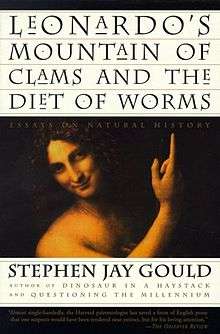Leonardo's Mountain of Clams and the Diet of Worms
 | |
| Author | Stephen Jay Gould |
|---|---|
| Publisher | Harmony Books |
Publication date | September 29, 1998 |
| Pages | 422 |
| ISBN | 0-609-60141-5 |
| OCLC | 38438624 |
| 508 21 | |
| LC Class | QH81 .G67323 1998 |
| Preceded by | Dinosaur in a Haystack |
| Followed by | The Lying Stones of Marrakech |
Leonardo's Mountain of Clams and the Diet of Worms (1998) is the eighth volume of collected essays by the Harvard paleontologist Stephen Jay Gould. The essays were culled from his monthly column "The View of Life" in Natural History magazine, to which Gould contributed for 27 years. The book deals, in typically discursive fashion, with themes familiar to Gould's writing: evolution and its teaching, science biography, probabilities and common sense.
From Publishers Weekly
- As in his previous collections of essays from Natural History magazine (Dinosaur in a Haystack, 1996, etc.), here again Gould artfully transports readers through the complex and enchanting realms of the natural world. This time, though, he peers less at nature than at scientists' attempts to understand and explain its wonders. Ranging far and wide through the history of science, Gould's sketches in "humanistic natural history" examine the "grand false starts in the history of natural science"? for he contends that nothing is as "informative and instructive as a truly juicy mistake". In an essay on the Russian paleontologist Vladimir Kovalevsky, for example, Gould applauds his subject's meticulously detailed observations on the fossils of horses and his consequent development of an evolutionary history of the horse as an animal of European descent. Yet, Gould points out, Kovalevsky was mistaken, for horses had evolved in America and migrated to Europe. Another famous "mistake" Gould explores is Emmanuel Mendes da Costas's taxonomy of earth and stones according to Linnaeus's taxonomy of organic life. As usual, Gould proceeds to his conclusions by indirection; he opens his essay on Mendes da Costa, for instance, by disclosing how Linnaeus compared the shape and function of a clam to female sexual anatomy. Gould's elegant prose transmits the excitement and wide-eyed wonder of a scientist who never ceases to be amazed and amused at what he finds. 30 b&w illustrations.
Reviews
- Book Summary: by Lawrence N. Goeller
- Book Review: by Jacqueline Boone, New York Times
- The Royal Road of Science: by Bryan Appleyard, Spectator
- Book review: by Jim Sullivan, Humanist
- Review by Graham Brack, Renaissance
- Book Review by Jim Walker
- Book summary: by Ryan Robinson
External Links
Profile Page (with introduction) - Unofficial Stephen Jay Gould Archive
This article is issued from Wikipedia - version of the 10/15/2016. The text is available under the Creative Commons Attribution/Share Alike but additional terms may apply for the media files.
